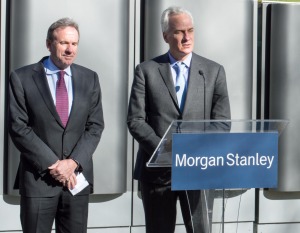It”™s half the size of a garage, makes about as much noise as an air conditioner and can power 160 average homes.
The fuel cell energy server built by Bloom Energy and installed behind Morgan Stanley”™s headquarters on Westchester Avenue will provide 250 kilowatts of power to the building, as well as keep the lights on should the power supply from the local grid fail. It is the second major green energy project at the company”™s Westchester campus, following the 2013 completion of a solar power field that can provide up to 5 percent of the power needed for the facility.

“We”™re completely committed as a firm to reducing our carbon footprint and increasing energy efficiency,” said Jim Rosenthal, Morgan Stanley”™s chief operating officer. “The Bloom Energy installation allows us to much more efficiently generate electricity from clean natural gas without suffering the loss of power that happens as it gets transmitted, and thus it doubly reduces our carbon footprint.”
Powered by a solid oxide fuel cell, the Bloom Energy Server installed at Morgan Stanley generates electricity from natural gas through a reaction with the natural gas, air, and proprietary components within the unit.
“We think that the Bloom Energy installation gives us additional electricity security to a point, which is important because we need redundant sources of power,” Rosenthal said. “The solar panels help, but of course, they only operate when it”™s sunny outside. The Bloom Energy installation can operate all the time.”
Based in Sunnyvale, Calif., Bloom Energy was founded in 2001 by K.R. Sridhar, a former NASA scientist who worked on fuel cell technology for the space program. Morgan Stanley was an investor in Bloom Energy, which has produced energy servers for clients ranging from Apple to Coca-Cola to the National Hockey League”™s San Jose Sharks.
“We”™ve always been interested in investing in the environment and we saw this technology as truly revolutionary,” Rosenthal said, when asked how Morgan Stanley identified Bloom Energy as an investment opportunity. “What will happen, I hope, going forward is that more electricity will be generated on site, so that they don”™t suffer a loss of power.”
Bloom Energy”™s product still requires a large investment, but tax subsidies and funding from sources such as the New York State Energy Research and Development Authority can give consumers a bit of a price break.
“This is a project where Morgan Stanley has invested a significant amount and will realize a significant savings,” said Bill Kurtz, Bloom Energy”™s chief financial and commercial officer, who declined to put a dollar figure on the cost of the installation. “They wouldn”™t do it if it did not provide a significant financial return.”
Kurtz said that he expects the technology to become more widespread as costs come down, a process that requires selling more energy servers and spreading the word about the product”™s benefits.
“As you build a business like this, you need scale to get the benefits that bring the costs down, and we”™re still at the very beginning of our growth curve,” Kurtz said. “Having customers like Morgan Stanley that invest in our technology ”¦ gets us to a point where we can get to scale and open this up more broadly. We definitely see within the next three to five years with our cost curves coming down and with the overall improvements in our technology that we can deploy this quite broadly.”
Kurtz said that Morgan Stanley”™s purchase of an energy server only bolsters the outlook for the company and its product.
“Morgan Stanley”™s confidence in installing it here, providing a significant portion of the load, that gives them a reliable source of energy that”™s also more cost-effective and environmentally favorable is a great validation of our technology,” Kurtz said.
Rosenthal indicated that this isn”™t the last sustainable energy project for Morgan Stanley.
“We have sustainable energy projects all the time,” he said. “I can”™t tell you what the next one will be, but we are looking at them constantly.”



















